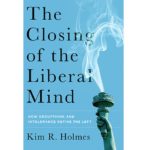Charles Murray’s 2012 book Coming Apart may have been the most prescient forecast of the anxiety and disaffection that power our current populist moment. Murray’s archetypal “Belmont” and “Fishtown” neighborhoods showed how socioeconomic self-segregation has led the well-off to inhabit a different America from the lower classes.
Tim Carney’s Alienated America, published earlier this year, is a worthy successor to Murray’s work. It should also be a summons to greater action. Carney, the commentary editor for the Washington Examiner, follows up on Murray’s analysis by visiting “Fishtowns” across the country, seeking to better understand the appeal of Trump’s promise that the “forgotten men and women of America will be forgotten no longer.” Taken aback by the 2016 election, the commentariat seized on any number of culprits, from boarded-up factories and changing demographics to a surge of opioid addiction. But Carney focuses a lens on the connective sinews that make a geographic place a community: the libraries, social clubs, and, most importantly, churches that provide structure and meaning to life lived socially.
A Crisis of Community
Carney sees the crisis of intermediary institutions as the defining difference between inhabitants of “Belmont,” like his own Chevy Chase, Maryland, and “Fishtown,” like western Pennsylvania’s Mon Valley.
Start your day with Public Discourse
Sign up and get our daily essays sent straight to your inbox.This is partly an economic story, but not entirely. Oostburg, Wisconsin is his favorite example of a modest town with a strong sense of interconnectedness, while the natural-gas-boom company towns of North Dakota are evidence that “[b]ad economics can help kill a community but good economics cannot, alone, rebuild one.” It is no accident, then, Carney suggests, that Chevy Chase and Oostburg—along with the state of Utah, noted for its strong social connectedness and faith-oriented community life—were the places where Candidate Trump did worst in the 2016 Republican primary; while the areas with thinner layers of civil society were more susceptible to a nostalgic appeal to America’s perceived bygone glory days.
Carney’s political analysis brings to mind New York Times columnist Ross Douthat’s quip that, if progressives thought they disliked the religious right, they should just wait to meet the post-religious right. Put in reductive terms, the book’s hook—that declining church attendance is how we got Trump—challenges conservative-leaning communities that have lost the muscle memory of committing to, and being shaped by, institutions.
Yet lest coastal elites get too smug about their marriage rates and institutional engagement, Carney astutely notes that too much social capital can be a bad thing. Exclusionary zoning, geographically rigid school districts, homeowners’ associations, gated communities, and other ways of delineating “our neighbors” from “those outsiders” often carry a whiff of classism (and racism) that sound like nothing more than a Chardonnay-fueled reprise of “Build the Wall!” In the name of preserving community character, opponents to plans that could alter a town’s socioeconomic makeup are making divisions worse. “We are keeping our most valuable asset [our networks and civil society] from the people who need it the most, the poor and working class,” Carney notes.
It would have been easy for Carney, whose career has focused on the crony capitalism beat, to spend the bulk of the book in his comfort zone, attacking government overreach, heavy-handed regulations, and welfare-state mission creep that has weakened civic organizations. This he does, but he also ventures into the harder task of explaining why the hollowing out of little platoons cannot entirely be blamed on shadowy elites and conniving globalists.
The Clustering of Social Capital
Part of the story is regional. The concentration of American prosperity into a handful of ultra-successful metropolitan hubs has not just had negative economic impacts on the mid-tier and small towns that have struggled to compete. Concentrations of human and social capital around New York City, Washington, DC, and San Francisco also act as magnets. Whereas prior generations might have aspired to be the president of a local bank or the editor of a mid-size newspaper, successful career pathways now run through a small number of power centers. As a result, Carney says,
The elite neighborhoods have plucked the would-be PTA presidents, the would-be small-town mayors, and the would-be leading local businessmen from hundreds of small towns and suburban and rural counties around American and jammed them into a few towns near Long Island Sound or a few blocks on either side of Connecticut Avenue.
There are only so many neighborhoods in America that get the dubious honor of being home to the “elite.” But as Carney’s counterexamples of Oostburg and Orange City, Iowa, demonstrate, the same kind of cultural cohesiveness can be achieved without undue influence or prosperity. I wonder what Carney would think of Pete Buttigieg, a scion of meritocracy who has made a brand out of his decision to return to his home town and invest in rebuilding civic life. Whatever one thinks of his policy stances, more Pete Buttigiegs willing to return to more mid-tier towns could arrest some of the decay that sets in when “brain drain” takes its toll.
The causal relationship between strong communities and strong marriage probably runs both ways. When one declines, the other does too. Thus, while the fluid marriages of Hollywood celebrities get media coverage, Carney rightly points out that bourgeois values are alive and well in the same urban centers attacked as hotbeds of social liberalism. “The retreat from marriage and the erosion of civil society aren’t happening in Chevy Chase and Princeton. They’re happening in Trump Country.” This goes for church attendance, too. The 2018 General Social Survey finds that high school graduates are 42-percent more likely to report never attending church than those with a college degree.
The Demise of the American Dream
We could quibble about the influence of church attendance on pro-social behaviors or wonder about the rise in forms of religion that demand less and affirm more. But Carney’s diagnosis gets at the existential malaise that affects too many individuals and too many families in too many towns and places throughout the United States.
Put aside the home, the car, and the paycheck, Carney says. Instead,
What if the T-ball game, the standing-room-only high school Christmas concert, the parish potluck, and decorating the community hall for a wedding—what if those activities are not the dressings around the American Dream, but what if they are the American Dream?
Using that definition, and given that a “huge swath of America lacks strong civil society,” we must conclude that “in much of the country . . . the American Dream really is dead.”
Let’s pause the tape. Assuming Carney’s diagnosis is correct—and to a large extent, I think it is—the impending demise of the “American Dream” would seem to call for strong medicine. Rod Dreher’s Benedict Option, maybe, or even the democratic socialism favored by certain subcultures on Twitter. Perhaps the inescapable working-out of modern capitalism really is the agglomeration of talent into a few, supercharged cities, leaving the rest of the country to wither on the vine; the consolidation of small businesses into corporate conglomerates that stand at a remove from community life; or the fetishization of consumer choice, turning matters of human life and the family into market goods. If so, then let the loom-smashing commence, and hand me a hammer.
But those outcomes seem to be less inevitable than a result of what we choose to optimize for and reward. In his most famous work, Daniel Bell wrote about the pervasive sentiment
that something is morally wrong with this country. . . . [Much] has been blamed on the government and “failed” government policies. But what about the role of free markets in fostering “decay”? The market is mechanism, yet its operations—what is bought and sold—are guided by the values in society.
The individuals and institutions that operate in a market society do still have some degree of freedom in choosing what to optimize their lives around. The way that we are formed and educated shapes the values that we choose to pursue. Without a robust counterweight to the logic of the market, we have let economic value become the most widely accepted measure of value. We have let meritocratic mobility be prioritized over invested rootedness, allowed the value of consumption to be prized over that of production, and treated the decline of social capital as irrelevant. These are not solely individual choices, but they are not unstoppable, impersonal forces either. The fault is not solely in our stock-ticker symbols, but also in ourselves.
Carney’s Solution
The “infertile virtue” of the elite, in Carney’s term, should lead us to desire a rebirth of institutions with persuasive—not coercive—power over the way we think about value and worth. Which brings this analysis back to Carney’s, admittedly, unsatisfying ultimate solution, which “is mostly: You should go to church. Also, you should start a T-ball team.” Necessary, undoubtedly. But is this sufficient?
Carney’s final chapter sketches out an implicit challenge to the visions offered by those who see faith communities as under siege, either doomed to preside over an inevitable yet gradual decline or awaiting a revanchist marriage between cross and crown. Paraphrasing Saint Irenaeus, the glory of God is a church community fully alive; with the drop-in babysitting availability of a YMCA; the residential density and fabric of a neighborhood surrounding an orthodox synagogue; the generational interconnectedness of a Little League field; the family-friendly meeting point of a coffee stand overlooking a playground; the structured welfare assistance of the Mormon community; and the camaraderie of the Knights of Columbus fish fries—all structured around the regular work of preaching, teaching, and worship that only a church can offer. Realizing this vision may be daunting, but it does not require an integralist state or a bunkered-down “option” that prioritizes self-preservation over evangelization.
Clearly, there is a chicken-and-egg problem here. How can institutions be engines of effective outreach without first attracting the critical mass of individuals to bolster those efforts? This is where the next generation of conservative policy thought should be focused: not just using the tools of civil society to achieve government’s ends, as in the marriage promotion programs of the early 2000s, but using the existing infrastructure of the state to creatively empower associations like churches and civic groups to become more necessary, more relevant, and more attractive to people’s lives. Again, the example of Utah is noteworthy here, as is the recent rise of classical Christian academies with an adjacent, flourishing social infrastructure.
Comparing our level of civic engagement to a bygone past is futile. It’s a lot more convenient to pay a construction company than rely on friends and neighbors for a barn raising. But the thick social fabric that Carney has in mind already exists in the well-off suburbs of DC and the ethnically homogeneous enclaves of the Midwest. This integrated way of living doesn’t have to be a luxury good, and the 2016 election vividly illustrated the depth of the problem.
Carney’s analogy is worth stealing. Just as removing paving stones doesn’t guarantee the grass below it will grow back, getting government out of the way (by repealing ridiculous religious liberty infringements and de-professionalizing some social service provisions) doesn’t mean that civil society will automatically spring back. A re-prioritization of social capital means tilling the field, resupplying our “little platoons,” developing a “capacitating conservatism” that places community-driven solutions at the top of not just our political agenda, but our cultural one as well.
This work need not wait for enabling legislation, the seizure of the means of production, or a national declaration of fealty to the pope. It can—and should—be undertaken today.














